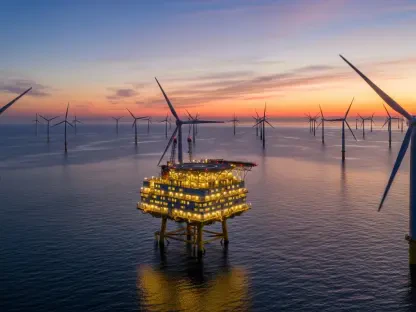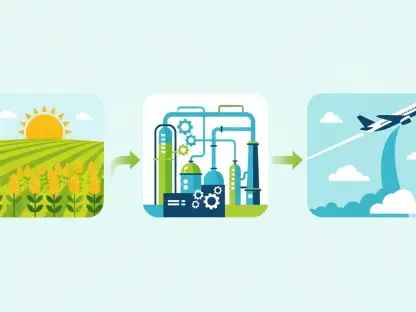Canada’s energy sector is at a critical juncture, facing potential upheaval due to threats from the United States to impose tariffs on Canadian energy imports. This development has sparked a nationwide debate on the future of Canada’s energy trade dynamics and the need for strategic shifts to enhance economic security and independence. These looming tariffs have not only underscored the vulnerabilities in Canada’s current energy trade relationship but also highlighted the urgent need for diversification and infrastructure development.
The Threat of U.S. Tariffs
President Donald Trump’s threats to impose tariffs on Canadian energy imports have sent shockwaves through Canada’s energy sector. The potential tariffs have highlighted the vulnerabilities in Canada’s current energy trade relationship with the United States, where 97% of Canadian oil is exported. This over-reliance on a single market has exposed Canada to significant economic risks, prompting calls for a reassessment of its energy strategy. Industry experts and policymakers are increasingly concerned about the economic impact of such tariffs. The potential loss of revenue and market access could severely affect Canada’s GDP, underscoring the need for a more diversified and resilient energy sector. The threat of tariffs has brought to the forefront the urgent need for Canada to explore alternative markets and reduce its dependency on the U.S.
The looming tariffs have sparked discussions on how Canada can hedge against such risks and maintain its economic stability. The unprecedented nature of these potential tariffs has brought about a sense of urgency among top governmental and industry officials. This urgency is evident in their push for legislative and strategic measures that will not only safeguard Canada’s economic interests but also ensure long-term resilience. At the heart of these discussions is the need to break away from a nearly exclusive reliance on the U.S. market, which has historically been both an advantage and a significant vulnerability for Canada’s energy sector.
Economic Vulnerability and Strategic Necessities
The economic vulnerability posed by Canada’s heavy reliance on the U.S. market for energy exports is a pressing issue. With the majority of Canadian oil being exported to the United States, any disruption in this trade relationship could have far-reaching consequences for the Canadian economy. This has led to a growing consensus that diversification is essential for economic stability. To mitigate these risks, experts advocate for the construction of new pipelines and the exploration of new export destinations. By expanding its infrastructure and market reach, Canada can reduce its economic exposure and enhance its national security. The development of new pipelines would not only facilitate the transportation of oil to other regions but also open up opportunities for international trade, providing a buffer against potential U.S. tariffs.
A significant part of the strategic necessity for Canada involves revisiting previously shelved projects and exploring new avenues for infrastructure development. There is a pressing need to integrate not just national strategies but also align with international trends in regard to energy trading and transport. This move towards diversification is seen as not just an economic imperative but a strategic one aimed at ensuring long-term national security. Experts suggest developing strategic partnerships with other countries, especially in Asia, to enlarge Canada’s energy market base and reduce over-dependence on the United States. This strategic pivot towards diversification must be multifaceted, involving governmental policy adjustments, robust diplomatic engagements, and industry-backed infrastructure projects.
Regulatory and Environmental Challenges
Despite the clear economic rationale for building new pipelines, past efforts have faced significant resistance from Indigenous groups and environmental activists. These groups have raised concerns about the environmental impact of pipeline construction and the potential risks to their lands and communities. As a result, several proposed pipeline projects have been stalled or rejected, complicating efforts to diversify Canada’s energy market. Balancing economic aspirations with environmental responsibilities remains a complex challenge. While the need for new infrastructure is evident, it is crucial to address the concerns of Indigenous communities and environmental advocates. This requires a collaborative approach that ensures sustainable development and respects the rights and interests of all stakeholders.
This delicate balancing act also involves abiding by existing legal frameworks and honoring agreements with Indigenous communities. The history of contentious relations regarding land use and resource extraction complicates the situation further, requiring a thoughtful, inclusive approach to future projects. Environmental regulations, too, play a substantial role in shaping the trajectory of pipeline development. These regulations mandate a thorough assessment of environmental impacts, and any infrastructural project must align with federal and provincial environmental laws. Addressing these concerns requires a participatory approach where all stakeholders are engaged in meaningful dialogue, thus ensuring that both economic and environmental goals are met without compromising sustainable development principles.
Political and Strategic Push for Diversification
Political figures and industry leaders are increasingly vocal about the need for Canada to diversify its energy sector. Alberta Premier Danielle Smith and Quebec’s Jean Charest have both emphasized the urgency of building more pipelines and revisiting previously rejected projects. They argue that a diversified energy market is essential for Canada’s economic security and long-term growth. The Canadian Association of Petroleum Producers (CAPP) has also been a strong advocate for market diversification and infrastructure investment. CAPP argues that expanding Canada’s pipeline network and exploring new export destinations are critical steps towards ensuring economic stability and resilience. By reducing its reliance on the U.S. market, Canada can enhance its negotiating power and protect itself from potential economic threats.
Diversification is seen as an essential strategic move that forms the crux of Canada’s response to the current threat of tariffs. Policymakers and industry leaders have pointed out that diversification is not just about building more pipelines but also about creating a comprehensive, multi-layered strategy. This strategy includes investing in alternative energy sources, fostering innovation within the sector, and developing new, sustainable energy projects. The political backing of such initiatives provides the necessary momentum to challenge previously held assumptions and spearhead the development of a more resilient energy sector. Harnessing this political will involves aligning federal and provincial strategies, ensuring a cohesive approach towards achieving energy independence and security.
Energy Security and Geopolitical Influence
Enhancing Canada’s energy security and geopolitical influence is another key consideration in the debate over diversification. By expanding its market reach and reducing its dependency on the U.S., Canada can strengthen its position on the global stage. This would not only boost national energy security but also increase Canada’s geopolitical leverage, allowing it to play a more influential role in international energy markets. A diversified energy sector would also provide Canada with greater flexibility in responding to global market trends and geopolitical developments. By having multiple export destinations, Canada can better navigate fluctuations in demand and price, ensuring a more stable and resilient energy sector.
Enhancing geopolitical influence through energy diversification also entails forming strategic alliances with other major global players in the energy markets. Canada can potentially collaborate with countries in Asia and Europe, which are constantly in search of reliable energy supplies. This broader, more strategic approach provides significant leverage in global geopolitics, enabling Canada to negotiate from a position of strength. Moreover, energy security is deeply intertwined with economic security. Ensuring that Canada’s energy supply and trading networks are stable and diversified strengthens the country’s overall economic resilience, making it less susceptible to external shocks. Such a strategy emphasizes the importance of maintaining and increasing domestic production capabilities while fostering international partnerships and trade agreements.
Environmental Considerations and Future Trends
While the push for diversification and new infrastructure is strong, environmental advocates caution against continued reliance on fossil fuels. They argue that investing in new oil infrastructure may not be viable in the long term, given the global shift towards renewable energy and sustainability. The transition towards renewable energy sources is seen as essential for addressing climate change and ensuring a sustainable future. Environmentalists emphasize the need for Canada to pivot towards renewable energy and sustainable practices. This includes investing in clean energy technologies and reducing greenhouse gas emissions. By embracing renewable energy, Canada can position itself as a leader in the global transition towards sustainability, ensuring long-term economic and environmental benefits.
The call for a transition towards renewables is not just based on environmental imperatives but also on emerging global economic trends. Leading economies worldwide are investing heavily in renewable energy sources and technologies, signaling an inevitable shift away from fossil fuels. As such, Canada’s long-term strategic interests may be better served by aligning with these global trends and securing its place in the renewable energy market. This involves significant policy shifts, investment in cutting-edge technologies, and a comprehensive reevaluation of Canada’s long-term energy strategies. Such a pivot represents an opportunity for Canada to innovate and lead in the global energy landscape, ensuring robust economic growth while meeting international environmental standards.
Balancing Economic and Environmental Goals
Canada is at a pivotal moment regarding its energy sector, with potential changes on the horizon due to threats from the United States to impose tariffs on Canadian energy imports. This potential action has sparked a considerable debate nationwide about the future of Canada’s energy trade and how the country should proceed to safeguard its economic stability and independence.
The threat of tariffs from the United States has exposed significant vulnerabilities in the current energy trade relationship between the two countries. This situation emphasizes the crucial need for Canada to consider substantial diversification of its energy markets. By expanding trade relationships beyond the United States, Canada could reduce its dependence on a single market, which would, in turn, mitigate similar risks in the future.
Moreover, this crisis underscores the importance of developing and enhancing infrastructure within the country. Enhanced infrastructure would enable more efficient energy distribution and better support for potential new trade relationships with other nations. By investing in infrastructure, Canada could ensure that it is not only able to meet its energy needs but also position itself as a significant player in the global energy market.
Ultimately, while the threat of tariffs poses an immediate challenge, it also presents an opportunity for Canada to rethink and reinforce its energy strategy. Through diversification and infrastructure improvements, Canada could emerge stronger and more resilient, better equipped to navigate the complexities of the international energy market.









